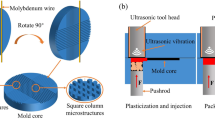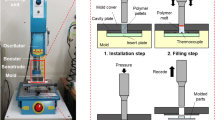Abstract
It is still a challenge to achieve the polymer replication of high aspect ratio micro-structured surface especially when the completed and unified replication quality is required. This paper shows a new method for the replication named ultrasonic vibration micro-injection mold (μUVIM) technology which combines the micro-injection mold (μIM) with ultrasonic vibration. An experimental mold that integrates micro-injection compression mold (μICM) and μUVIM has been designed. In this paper, the effect of important process parameters on the replication quality of microstructure was studied via μUVIM experiment, and the process parameters were optimized through the response surface method (RSM). Compared with replication methods based on μICM technology, the μUVIM technology discussed in this paper can increase the average height of the microstructure by 14.6% and increase the production efficiency by three times. Moreover, it has been found that the μUVIM technology is insensitive to the thickness of the polymer substrate, so it can widen the processing scope of microstructure with high aspect ratio.








Similar content being viewed by others
References
Bobzin K et al (2006) New soldering processes and solder systems for hybrid microsystems: developments and applications. Microsyst Technol 12:620–625
Christiansen AB, Clausen JS, Mortensen NA, Kristensen A (2014) Injection moulding antireflective nanostructures. Microelectron Eng 121:47–50
Hattori S, Nagato K, Hamaguchi T, Nakao M (2010) Rapid injection molding of high-aspect-ratio nanostructures. Microelectron Eng 87:1546–1549
Hong S, Min I, Yoon K, Kang J (2014) Effects of adding injection-compression to rapid heat cycle molding on the structure of a light guide plate. J Micromech Microeng 24:5009
Hong S, Hwang J, Kang J, Yoon K (2015) Comparison of injection molding and injection/compression molding for the replication of microstructure. Korea Aust Rheol J 27:309–317
Huang MS, Chung CF (2011) Injection molding and injection compression molding of thin-walled light-guided plates with V-grooved microfeatures. J Appl Polym Sci 121:1151–1159
Iclanzan T, Serban I, Rotar D, Tut V (2010) Ultrasonic activation, a possible alternative application in the microinjection molding. IntJ Mater Form 3:547–550
Jiang BY, Hu JL, Li J, Liu XC (2012) Ultrasonic plastification speed of polymer and its influencing factors. J Cent South Univ 19:380–383
Kosloh J, Sackmann J, Šakalys R, Liao S, Gerhardy C, Schomburg W (2017) Heat generation and distribution in the ultrasonic hot embossing process. Microsyst Technol 23:1411–1421
Lee HS, Yoo YG (2012) Effects of processing conditions on cavity pressure during injection-compression molding. Int J Precis Eng Manuf 13:2155–2161
Lucchetta G, Sorgato M, Carmignato S, Savio E (2014) Investigating the technological limits of micro-injection molding in replicating high aspect ratio micro-structured surfaces. CIRP Ann Manuf Technol 63:521–524
Lucchetta G, Sorgato M, Zanchetta E, Brusatin G, Guidi E, Liddo RD, Conconi MT (2015) Effect of injection molded micro-structured polystyrene surfaces on proliferation of mc3t3-e1 cells. Express Polym Lett 9:354–361
Luo Y, Zhang Z, Wang X, Zheng Y (2010) Ultrasonic bonding for thermoplastic microfluidic devices without energy director. Microelectron Eng 87:2429–2436
Masato D, Sorgato M, Lucchetta G (2016a) Analysis of the influence of part thickness on the replication of micro-structured surfaces by injection molding. Mater Des 95:219–224
Masato D, Sorgato M, Lucchetta G (2016b) Characterization of the micro injection-compression molding process for the replication of high aspect ratio micro-structured surfaces. Microsyst Technol 23:3661–3670
Metwally K, Barriere T, Khan-Malek C (2016) Replication of micrometric and sub-micrometric structured surfaces using micro-injection and micro-injection compression moulding. Int J Adv Manuf Technol 83:779–789
Michaeli W, Kamps T, Hopmann C (2011) Manufacturing of polymer micro parts by ultrasonic plasticization and direct injection. Microsyst Technol 17:243–249
Nonhof CJ, Riepen M, Melchers AW (1996) Estimates for process conditions during the vibration welding of thermoplastics. Polym Eng Sci 36:2018–2028
Runge T, Sackmann J, Schomburg WK, Blank LM (2016) Ultrasonically manufactured microfluidic device for yeast analysis. Microsyst Technol 23:2139–2144
Rytka C, Kristiansen PM, Neyer A (2015) Iso- and variothermal injection compression moulding of polymer micro- and nanostructures for optical and medical applications. J Micromech Microeng 25:065008
Sorgato M, Masato D, Lucchetta G (2016a) Effect of vacuum venting and mold wettability on the replication of micro-structured surfaces. Microsyst Technol 23:2543–2552
Sorgato M, Babenko M, Lucchetta G, Whiteside B (2016b) Investigation of the influence of vacuum venting on mould surface temperature in micro injection moulding. Int J Adv Manuf Technol 88:547–555
Su Q, Zhang N, Gilchrist MD (2016) The use of variotherm systems for microinjection molding. J Appl Polym Sci 133:1–17
Tolunay MN, Dawson PR, Wang KK (1983) Heating and bonding mechanisms in ultrasonic welding of thermoplastics. Polym Eng Sci 23:726–733
Truckenmüller R, Ahrens R, Cheng Y, Fischer G, Saile V (2006) An ultrasonic welding based process for building up a new class of inert fluidic microsensors and -actuators from polymers. Sens Actuators A Phys 132:385–392
Wu W, Peng H, Jia Y, Jiang B (2017) Characteristics and mechanisms of polymer interfacial friction heating in ultrasonic plasticization for micro injection molding. Microsyst Technol 23:1385–1392
Xu G, Yu L, Lee LJ, Koelling KW (2005) Experimental and numerical studies of injection molding with microfeatures. Polym Eng Sci 45:866–875
Yang SY, Chen YC (1998) Experimental study of injection-charged compression molding of thermoplastics. Adv Polym Technol 17:353–360
Zhu J, Tian Y, Yang C, Cui L, Wang F, Zhang D, Liu X (2017) Low-cost and fast fabrication of the ultrasonic embossing on polyethylene terephthalate (PET) films using laser processed molds. Microsyst Technol 23:5653–5668
Acknowledgements
This research is supported by Science and Technology Planning Project of Guangdong Province under Grant nos. 2015B090921007 and 2015B010919001.
Author information
Authors and Affiliations
Corresponding author
Rights and permissions
About this article
Cite this article
Liu, J., Chen, X. & Diao, S. Ultrasonic vibration technology for the polymer replication of high aspect ratio micro-structured surface. Microsyst Technol 24, 2253–2264 (2018). https://doi.org/10.1007/s00542-017-3632-1
Received:
Accepted:
Published:
Issue Date:
DOI: https://doi.org/10.1007/s00542-017-3632-1




